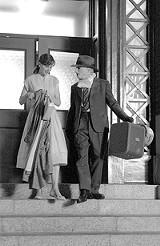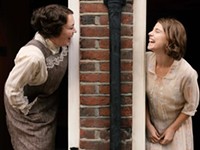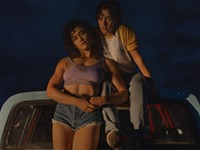"Fur"
The "imaginary portrait" of photographer Diane Arbus is a faux pas
By Dayna Papaleo @daynadoesdishes[
{
"name": "500x250 Ad",
"insertPoint": "5",
"component": "15667920",
"parentWrapperClass": "",
"requiredCountToDisplay": "1"
}
]
A dish of scrambled stars
Movies
Director Steven Shainberg's debut film, you may recall, was 2002's Secretary, an off-kilter romance between a timid administrative assistant and the roughly adoring lawyer who indulged her masochistic whims. For his sophomore picture, the puzzling and indulgent Fur, Shainberg remains on the fringes of society, creating what the film's subsidiary title calls "an imaginary portrait" of photographer Diane Arbus, famed for her stark images of those who didn't fit the mold. This movie lovingly refers to these unique individuals as "freaks."
The "imaginary portrait" conceit allows Shainberg and screenwriter Erin Cressida Wilson (she also scripted Secretary) to sail through a number of loopholes, the first of which is the (mis)casting of leggy, creamy Nicole Kidman in the role of the darkly petite Arbus. Fur opens in 1958 as Diane (pronounced "dee-ann") is in frantic preparations for a fashion show, assisting her furrier father and commercial photographer husband. Various behaviors make it obvious that Diane is straining against the notion of what's expected of a '50s wife and mother, and her growing fascination with the new, masked neighbor sends Diane, an aspiring photographer in her own right, down the rabbit hole and up the stairs into his apartment, twin-lens reflex in hand. She's hoping to take his picture, or maybe the camera is just an excuse.
This shrouded gentleman is Lionel Sweeney, and the biggest brush with which Fur paints its "imaginary portrait." Lionel wears a mask because he suffers from a genetic condition that has left him covered from stem to stern in long, luxuriant locks. As played by a Chewbacca costume housing Robert Downey Jr., Lionel is a made-up character, representing the inspiration that enabled Diane to accept and even embrace her own freak-like impulses, thus finding an outlet for her creativity.
So Lionel prods the initially shocked Diane with questions about sex and her childhood and then introduces the sheltered woman to his domain, a place filled with midgets, giants, dominatrices, drag queens, and the limbless --- people with whom the upper-class Diane would never have otherwise consorted. But Fur's fatal decision is to allow Beauty to embark on a tentative romance with her fictitious Beast, stretching the metaphor for an awakening passion too thin and turning the film into a sudsy mess.
Physicality aside, the continually overrated Kidman is all wrong as Diane, though it's not entirely her fault. The camera spends an astonishing amount of time lingering over her alabaster veneer and cornflower blue eyes, but we never catch a glimpse as to what's going on behind any of it. Everyone suffers from ennui, but only a few desert their family in pursuit of its remedy, and it would be instructive to understand the reasoning behind such a drastic decision other than basic boredom.
Downey had been on a hot streak as of late, with deft work in Good Night and Good Luck and Kiss Kiss Bang Bang under his belt. Lionel is a bit of a misstep that must have sounded intriguing on paper to this notorious risk-taker. Downey's great sad eyes are called upon to do most of his acting for him under that massive wall of hair, a task they're more than capable of. When he opens his mouth, however, Lionel comes off like a haughty James Spader type, possibly a defense mechanism against an unkind world but not at all helpful in garnering sympathy... unlike his Camille-esque cough. The shaving scene, however, is sorta hot. Nice touch to leave the eyebrows.
Your enjoyment of Fur, as with any movie, will depend on your willingness to accept what you're being fed. This "imaginary portrait" construction, in case you couldn't tell, infuriates me. Aren't most films imaginary portraits? Even the most straightforward biopic takes the occasional liberty. Fur is a fairy tale, pure and simple, but by invoking the Arbus name it opens up a can of worms that should have been respectfully wrangled.
The real Diane Arbus studied under Richard Avedon, exhibited at the Museum of Modern Art, and worked both as a photojournalist and teacher, ending her life in 1971 by swallowing a bunch of barbiturates and then opening up her wrists (no cry for help, that). Perhaps the filmmakers were wary of such a feel-bad ending, recent films like the Kurt Cobain movie Last Days and Gwyneth Paltrow'sSylvia arriving in theaters to resounding apathy. But judging from the surface scratched in Fur, there's plenty of material to fuel an exploration of Diane Arbus that would no doubt have been far more resonant and vital than simply an "imaginary portrait."
Fur (R), directed by Steven Shainberg, is now playing at Little Theatres.
Speaking of...
-
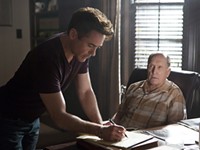
Film Review: "The Judge"
Oct 14, 2014 -
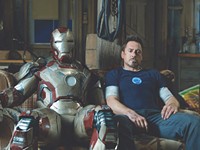
"Iron Man 3"
May 8, 2013 - More »
Latest in Movie Reviews
More by Dayna Papaleo
-
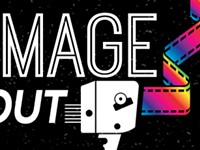
Festival Preview: ImageOut 2017
Oct 4, 2017 -
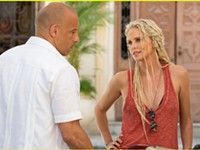
Film review: 'The Fate of the Furious'
Apr 17, 2017 -
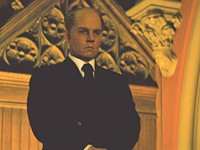
Rat tales
Sep 23, 2015 - More »
